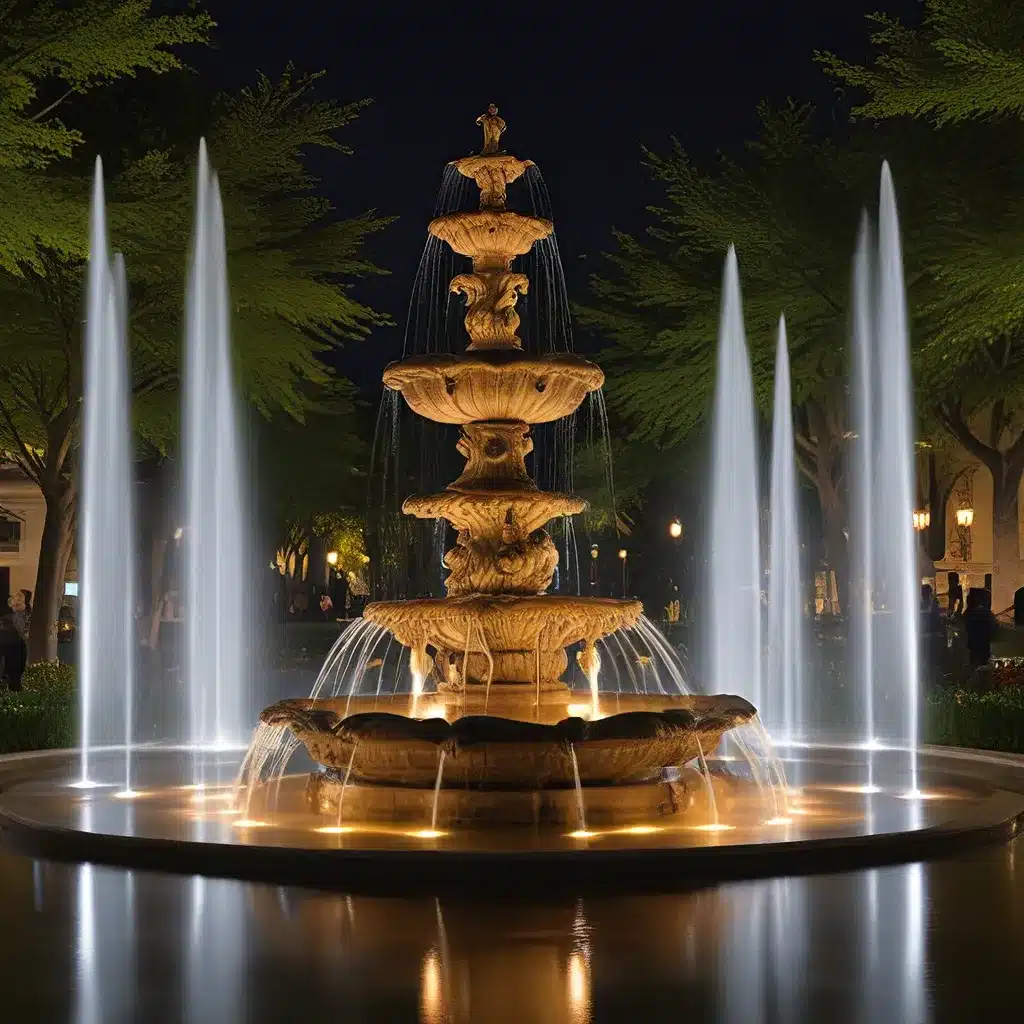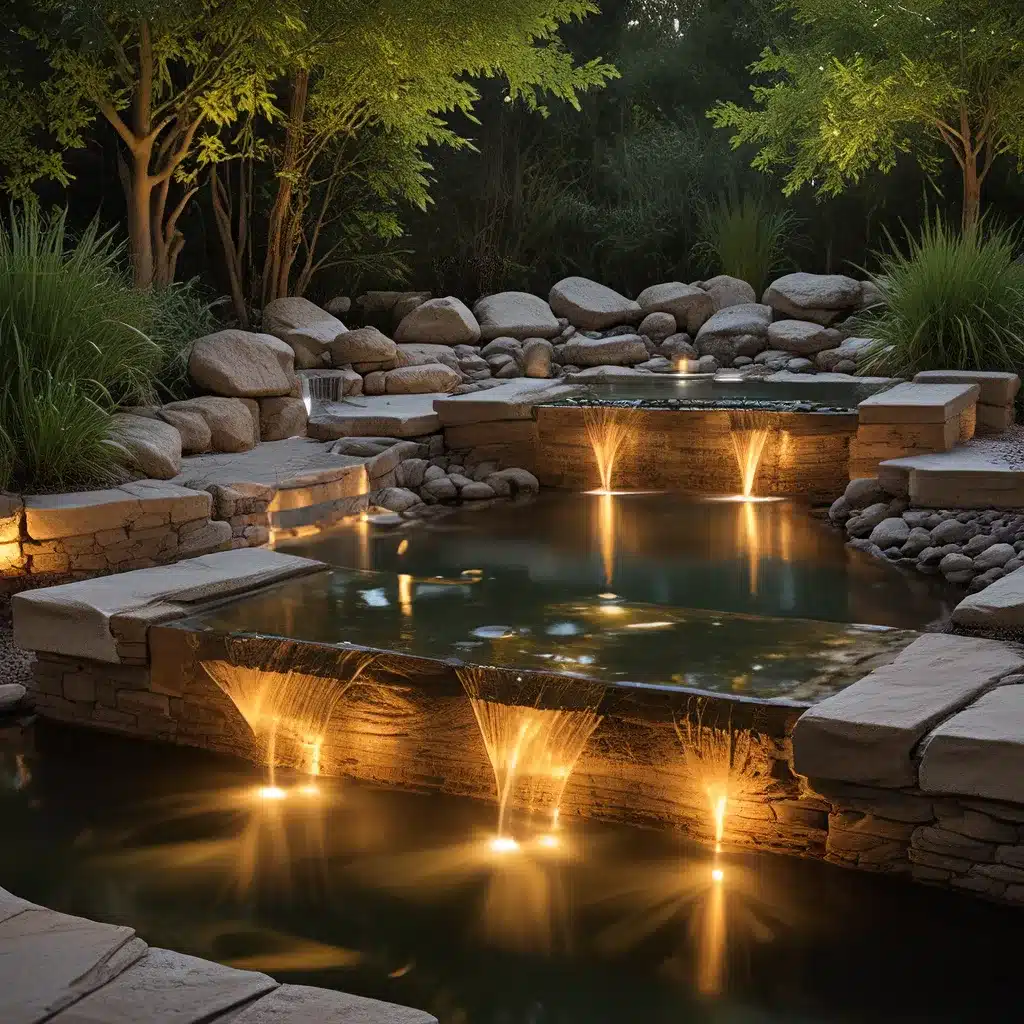
Fountain Design Essentials – Welcome to Fountain Lights
Fountain Design Essentials – Welcome to Fountain Lights

When it comes to water features, the way light interacts with the surface is a crucial element in creating a visually captivating and harmonious design. The reflection of light on water is a complex and fascinating phenomenon governed by the fundamental principles of optics and physics.
At its core, the reflection of light on water is a result of the difference in the refractive index between air and water. As light passes from the air into the water, it bends and changes direction, creating the illusion of an inverted image mirrored on the surface. This effect is known as specular reflection, and it’s what gives water features their mesmerizing and tranquil appearance.
But the story doesn’t end there. The quality and characteristics of the reflected light can be influenced by a variety of factors, including the angle of the light, the smoothness of the water surface, and even the depth of the water body. Mastering these nuances is the key to crafting water features that truly captivate the senses and evoke a sense of serenity.
One of the most fascinating aspects of light reflection in water features is the interplay between refraction and reflection. As light passes from the air into the water, it bends and changes direction, creating a distorted and magnified view of objects beneath the surface.
This refraction effect can be used to great advantage in the design of water features. By carefully controlling the depth and shape of the water body, designers can create optical illusions that add depth, movement, and visual intrigue to the overall composition. Imagine a shallow pool that appears to have a much deeper bottom, or a fountain that seems to defy gravity as the water appears to “float” in midair.
The key to harnessing the power of refraction is understanding the mathematical principles that govern the behavior of light. By mastering the laws of refraction and Snell’s law, designers can precisely calculate the necessary water depth, surface curvature, and light angles to achieve their desired effects.
With a solid understanding of the physics behind light reflection, designers can start to explore the myriad of techniques and considerations that go into creating truly captivating water features. Here are some of the essential elements to keep in mind:
Surface Smoothness: The smoothness of the water surface plays a crucial role in the quality and clarity of the reflected image. Ripples, waves, and turbulence can distort and fragment the reflection, while a smooth, still surface can produce a mirror-like effect.
Lighting Angle: The angle at which light strikes the water surface directly affects the intensity and direction of the reflection. Careful placement and control of lighting sources can create dramatic and visually striking reflections.
Depth and Shape: The depth and shape of the water body can be manipulated to create unique and mesmerizing reflections. Shallow pools can produce distorted and magnified reflections, while deeper bodies of water can create a sense of depth and infinity.
Color and Contrast: The colors and contrasts within the water feature can also influence the reflected light. Darker water surfaces, for example, can create a more muted and atmospheric reflection, while lighter colors can produce a brighter, more vibrant effect.
Motion and Dynamism: Incorporating movement and dynamism into the water feature can add an extra layer of visual interest and captivation. Fountains, waterfalls, and cascades can create ever-changing reflections that dance and shimmer across the surface.
By mastering these techniques and considerations, designers can craft water features that truly dazzle and enchant. From serene reflecting pools to awe-inspiring fountains, the possibilities for harnessing the power of light reflection are endless.
To truly appreciate the transformative power of light reflection in water features, let’s explore some inspiring examples from around the world.
The fountains at the Bellagio in Las Vegas are a prime example of reflective radiance in action. The choreographed water displays, accompanied by music and dynamic lighting, create a mesmerizing spectacle that captivates audiences with their seamless interplay of light, motion, and reflection.
In Japan, the tranquil gardens of the Kenrokuen in Kanazawa are renowned for their stunning reflective ponds. The smooth, mirror-like surfaces reflect the surrounding landscape, creating a serene and otherworldly atmosphere that transports visitors to a realm of pure contemplation.
Across the globe, the Infinity Pools of Singapore have become iconic examples of how light reflection can be used to create a sense of boundless spaciousness and depth. The crisp, clean reflections of the sky and cityscape on the water’s surface create an illusion of a never-ending horizon, blurring the lines between reality and the surreal.
These are just a few of the many inspiring examples that demonstrate the power of light reflection in water features. By understanding the underlying principles and techniques, designers can unlock a world of possibilities, crafting water features that captivate the senses and leave lasting impressions on all who experience them.
As you embark on your own journey of designing and creating water features, I encourage you to embrace the reflective radiance that lies at the heart of these mesmerizing elements. By delving into the science of light reflection and harnessing its power, you can elevate your projects to new levels of artistry and enchantment.
Remember, the key to mastering light reflection in water features is not just about technical proficiency, but about a deep understanding of the interplay between physics, optics, and human perception. It’s about crafting experiences that captivate the senses and leave a lasting impression on the viewer.
So, let your creativity soar, and let the reflective radiance guide you on your path to creating truly remarkable water features. Dive deep into the science, experiment with different techniques, and never stop exploring the endless possibilities that lie at the intersection of water, light, and the human imagination.
Fountain Lights is here to support you on this journey, providing the expertise, resources, and innovative solutions to help you bring your reflective radiance dreams to life. So, what are you waiting for? Let’s dive in and uncover the full potential of light reflection in water features!
Share to :
Subscribe to our newsletter for the latest in fountain design, innovative lighting ideas, and exclusive tips straight to your inbox. Join the community shaping the future of water features.

Rapid delivery to your doorstep.

Excellence in every product.

Great value for your investment.

Assistance at any hour.
Fountain Lights — Illuminating creativity in every splash!
Copyright © 2023. All Right Reserved